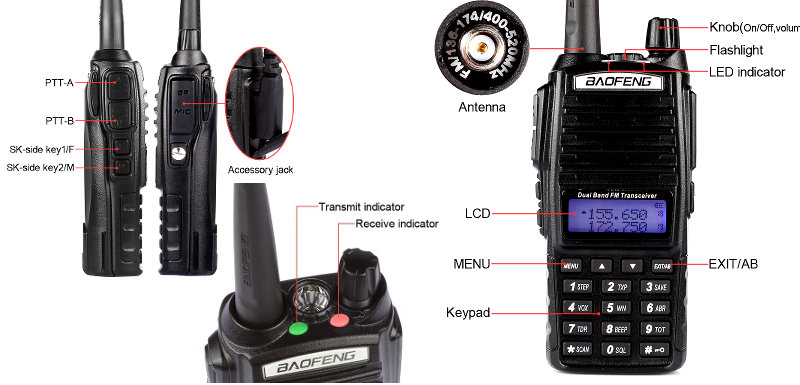Difference between revisions of "Baofeng UV-82"
m |
m |
||
| Line 9: | Line 9: | ||
[[Image:baofengUV82buttonsfunctions.jpg]] | [[Image:baofengUV82buttonsfunctions.jpg]] | ||
| + | |||
| + | * 128 Channels at 25KHz (wide band)12.5KHz (narrow band) | ||
| + | * Sensitivity ≤0.25μV (wide band) ≤0.35μV (narrow band) | ||
| + | * Operates at 7.4V DC ±20% from a 1800mAh | ||
| + | * Frequency step selection of 2.5, 5, 6.25, 10, 12.5, 20, 25, 30 and 50KHz | ||
| + | * Relative xmit power depends on model, standard is 5W / 1W or 2W on 220 | ||
| + | * Audio Power Output 1000mW/10% (1 Watt) | ||
== Review == | == Review == | ||
Revision as of 12:02, 8 October 2018
These are an economical Dual Band UHF/VHF Amateur Radio. The UV-82 series of radios feature a rocking Push-to-Talk button which allows you to transmit on two frequencies depending on how you push the button. By pressing up you can transmit on "Frequency A" and by pushing down you can transmit on "Frequency B".
Improvements over the Baofeng UV-5R include a louder speaker (1 watt), rugged case, larger buttons, and more powerful control processor. The radio barrows from design qualities of commercial Part 90 radios. The battery compartment has better contacts to prevent issues common with older Baofeng radios during off when the battery contact became intermittent.
There are variations of the UV-82. Some are listed here:
- Baofeng UV-82 - Dual Band VHF/UHF TX 136 - 174MHz, 400 - 520MHz for ham / amateur radio
- Baofeng UV-82C - Dual Band VHF/UHF TX 136 - 174MHz, 400 - 520MHz, VFO lockout, C "Commercial" claims to be Part 90 type accepted
- Baofeng UV-82L - Dual Band VHF TX TX 136 - 174MHz, 220 - 260MHz for ham / amateur radio (possibly a UHF variant also available)
- 128 Channels at 25KHz (wide band)12.5KHz (narrow band)
- Sensitivity ≤0.25μV (wide band) ≤0.35μV (narrow band)
- Operates at 7.4V DC ±20% from a 1800mAh
- Frequency step selection of 2.5, 5, 6.25, 10, 12.5, 20, 25, 30 and 50KHz
- Relative xmit power depends on model, standard is 5W / 1W or 2W on 220
- Audio Power Output 1000mW/10% (1 Watt)
Review
They are not manufactured to the standards of Kenwood, Icom, or Yaesu, however, for a fraction of the price they have a good place in the market for those on a budget. This is especially useful for a small business wishing to purchase quantities.
